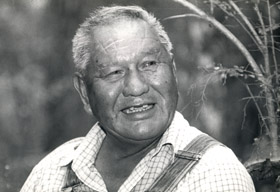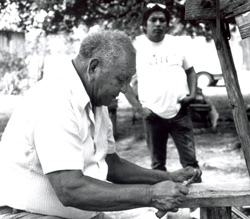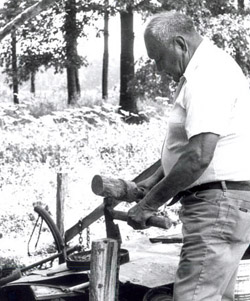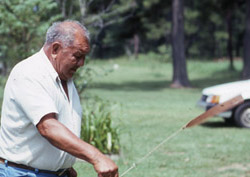Table of Contents
Introduction
Profiles of Masters and Apprentices

The present-day Koasati (also known as Coushatta) Indians of Louisiana live on a reservation near Elton in Allen Parish. At the time of initial white contact, the Koasati resided in the state of Alabama. In an attempt to retreat from colonization, they had migrated to Louisiana by 1795. In 1884, the Koasati acquired their present lands.
Bel Abbey, who died January 21, 1992 at the age of 75, lived his entire life on a tract of land not far from the Koasati Tribal Center that he and his brothers and sisters inherited from their mother. For a while, Bel made a living by farming his land, but it was very difficult for a small farmer to support himself and his family in this day and age of large-scale, single crop farming. Bel also raised chickens and cattle for a while, but it was more lucrative to work as a farm laborer for the big operations. While Bel Abbey was paid to grow rice and soybeans, his boss went to work as a postmaster.
Bel Abbey continued to grow a garden on his own land every year--even after retiring from his job. The garden provided the Abbey family with fresh squash, hull beans, cucumbers, potatoes, onions, and tomatoes. Other activities included making toys of various types, as well as blowguns, bows and arrows (both for children and adults). Bel was also a prolific storyteller. He learned the stories from his mother's brothers who reared him from the time he was two years of age, after the death of his father.
Among the Koasati, matrilineal kinship is of great importance. For example, land is inherited from the mother, rather than the father. It is likely that even if his father had not died, Bel Abbey would have had a close relationship with his maternal uncles. The mother's brothers were, and still are, responsible for the education and discipline of their sister's children. The biological father's first responsibility is to his nieces and nephews.
Nighttime was the usual time for storytelling. After the day's work was ended, the family would sit by the fireside, and a good story provided entertainment and relaxation. Many of the tales also involved a teaching/learning experience. This was the manner in which the Koasati legends and lore were passed on. It was also the avenue for exchange of day to day information such as the habits of certain animals, knowledge which would be useful in hunting. Two examples of animal stories that Bel Abbey told are the story about the rabbit that out-smarted the dog, and the one of the terrapin and the rabbit that ran a race. Many of the stories are quite funny and "some of them are scary," said Bel.
Naturally when Bel's uncles told stories, they spoke in the Koasati language because at that time little or no English was spoken among the tribal members. As a boy, Bel did go to school, but on a very irregular basis, and he completed his formal education with the fourth grade. The school he attended was an all-Indian school at the Congregationalist Church partially funded by the Bureau of Indian Affairs. The Koasati school remained in operation until the 1960s. It was there that Bel Abbey got acquainted with his wife, although they had actually known each other all their lives. They were married when Bel was twenty-two years of age and his wife was two years younger. They had three daughters, several grandchildren, and great-grandchildren. The Abbey family is very close knit, and they have endured a lot of hard times on the farm. Abbey spoke of those hard times with a sense of humor and said, ". . . but I made it!"
Today, the older and younger generations still prefer to speak in their native language; however, the children are learning English in the public schools and are more comfortable in their second language than their elders had been. Some of the adults, as Bel Abbey did, are trying to preserve their language by speaking only Koasati to the children and grandchildren at home.
Neighbor children, in addition to his own family members watched as Bel produced enchanting animal shapes, spinning tops, and puzzles out of mere pieces of wood. While he worked, Abbey also told stories and taught his audience the Koasati names of his creations, as well as the names of the tools and materials that he used. The children also received lessons in bird hunting with the bows and blowguns he made.
According to Abbey, the best time to gather wood for his carvings is the winter because there isn't as much sap flowing. Some of his blowguns are made from cane and others from a stick taken from the elderberry bush. The sticks have to be straightened. He worked them into shapes while "wet," just after being cut; then he placed them between two objects that will keep them straight until they dried. Bel Abbey made small wooden darts to use with the blowguns. These can be projected quite a distance if you know what you are doing.
In order to make a good bow, Bel liked to find a piece of hickory trunk about four feet long, with no knots in it. He would split it in half and make two bows. The wood was shaped and also scraped and smoothed. A piece of broken glass was the tool Bel used to produce a beautiful, perfectly smooth bow. These days a bow string is purchased from a store, but Bel also knew how to make a bow string from a piece of animal hide, which was the only available material when he was growing up. The entire process of bow making takes about one week. Arrows are also made of a hickory stick with a sharpened end. In the old days, said Abbey, they used stone arrowheads, but he had not used those in quite sometime. Prior to acquiring guns to use for hunting, the Koasati killed ducks and squirrel as well as birds with their bows and arrows.
For several years, Bel Abbey participated in the annual Louisiana Folklife Festival, giving demonstrations with his toys and children's games, as well as entertaining with narrative stories. In the summer of 1985, he was chosen to participate in the Festival of American Folklife sponsored by the Smithsonian Institution in Washington, D.C. It was the first time he had flown in an airplane, and sometimes that experience was re-lived in Abbey's storytelling. Bel's gift for telling tales resulted in his frequent appearance at the 1990 Louisiana Open House Storytelling Pavilion as well.
Through the Louisiana Folklife Apprenticeship Program, Bel Abbey and his apprentice and nephew, Timothy Langley had the opportunity to take time to preserve these fascinating Koasati stories, legends, and crafts.






